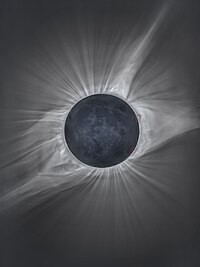User:ZethyHere/sandbox/NASA Eclipse MegaMovie 2024

The Eclipse Megamovie 2024 (EM2024) project is a Sonoma State University hosted citizen science project with the help of the University of California, Berkeley with funding from NASA, that has a goal of having it's members take a photo of the solar corona during totality, more specifically the transient plasma flows and jets in the corona[1], and to use the photos as data to study the corona of the Sun as it is eclipsed by the Moon. EM2024 also has a secondary goal of showing the movement of the corona during the April 8th, 2024 total solar eclipse[2], which is visible mainly in North America, but is visible in parts of South America and Europe.
History
[edit]Creation
[edit]The idea of the project was created in 2011, by Dr. Hugh Hudson from the Space Sciences Laboratory at the University of California, Berkeley.[3]
Eclipse Megamovie 2017
[edit]The project officially started in 2017, under the name of the Eclipse Megamovie 2017, and was solely hosted by the Sonoma State University. On August 21st, 2017, over 2,000 people who had volunteered had submitted 50,000 photos for the project. The first "movie" was released a few months after the eclipse, and was processed to create High Dynamic Range images.[4]
Finishing the Movie
[edit]The Space Sciences Laboratory at the University of California, Berkeley put the images together and gave an extended look at the Sun's atmosphere. The finished video was released in September of 2018 by UC Berkeley graduate student Juan Camilo Guevara Gomez, with help from undergraduate Tushar Singla. The main goal of the project was to make a high-definition video of the solar eclipse as it went across North America.[5]
The Teams
[edit]There are four teams of the NASA Eclipse Megamovie 2024, being the Science Team Alpha Recruits (STARs), the Python/Machine Learning (ML) team, the Volunteer Scientists, and the Eclipse Megamovie Chasers. The STARs are the main team, and will be taking photos of the solar corona while also being supplied with specific equipment.[6] The Python/ML team is for people who have experience in coding with Python or implementation of machine learning (or AI) to arrange photos and data.[7] The Volunteer Scientists are similar to the STARs, but without receiving specific equipment from EM2024. The Eclipse Megamovie Chasers are trying to get more people to join the project, mainly through social media.
Capturing the Sun
[edit]
EM2024 plans to use equatorial (EQ) mounts with a DSLR camera attached to take a photo of the solar corona. 100 EQ mounts were 3D printed and are being shipped out to the STARs which are people that met the requirements. EM2024 encourages people to use Stellarium to help figure out when the eclipse starts, when totality is, and when the eclipse ends.[8] It is also encouraged by EM2024 to try and get more data even if the EQ mount wasn't received by the person, mainly by still taking a photo of the Sun, just without tracking.[9]
References
[edit]- ^ The goals of EM2024 are to characterize transient plasma features in the solar corona while improving the quality of the Eclipse Megamovie aesthetically. https://eclipsemegamovie.org/goals "Primary Science Goals"
- ^ By stitching together thousands of images taken along the path of the 2017 total solar eclipse, the project created a unique treasure-trove of information on how the corona changes over time. https://eclipsemegamovie.org/goals "Expected Scientific Discoveries"
- ^ In 2011, Dr. Hugh Hudson from the Space Sciences Laboratory at the University of California, Berkeley, with renowned solar eclipse expert Dr. Jay Pasachoff, in proposing the idea of the Eclipse Megamovie Project. https://eclipsemegamovie.org/ "The Beginning"
- ^ Over 2,000 volunteers submitted 50,000 images and a movie was made only a few hours after the eclipse. A few months later another, better aligned and more closely edited, movie was released, and using High Dynamic Range (HDR) images to capture the structures within the high dynamic range of the solar corona from the Sun's photosphere. https://eclipsemegamovie.org/ "EM2017"
- ^ A team at the Space Sciences Laboratory (SSL) at the University of California, Berkeley stitched images together of the project to give an extended look at the Sun's atmosphere. The resulting video was completed in September 2018 by UC Berkeley graduate student Juan Camilo Guevara Gomez with assistance from undergraduate Tushar Singla. https://eclipsemegamovie.org/ "EM2017"
- ^ In exchange for volunteering and attending training's, 100 participants of the STARs will receive an equatorial mount for their tripod-camera system. https://eclipsemegamovie.org/team/volunteers "STARs"
- ^ The project is looking for any volunteers who are proficient in Python code or implementation of Machine Learning (AI) in the arranging of photographs or other data. People who sign up to help analyze solar eclipse images for transient plasma flows in the solar corona, will be provided with the competition information so they can access the python code and competition requirements. https://eclipsemegamovie.org/team/volunteers "Python/ML"
- ^ Stellarium is a visual tool that can help visual what astronomical events will look like in the sky. This tool is also able to simulate eclipses. https://eclipsemegamovie.org/visualize
- ^ Having a DSLR camera and tripod and a solar filter, allows the person to join the Volunteer Scientists. https://eclipsemegamovie.org/team/volunteers "Volunteer Scientists"
Further Reading
[edit]- The projects website: https://eclipsemegamovie.org/
- The NASA page about it: https://science.nasa.gov/get-involved/citizen-science/know-python-or-have-a-dslr-camera-the-eclipse-megamovie-needs-your-help/
- The Sonoma State University page about it: https://orsp.sonoma.edu/awards/eclipse-megamovie-2024-characterizing-transient-plasma-flows-and-jets-solar-corona-em2024
- NSTA page on it: https://www.nsta.org/science-scope/science-scope-julyaugust-2023/megamovie-2024-project-eclipse-all-others
- ScienceNews page on it: https://www.sciencenews.org/article/citizen-scientists-2024-solar-eclipse
- KWTX video with one of the organizers of the project: https://www.kwtx.com/2023/12/05/degrees-science-2024-eclipse-megamovie/
